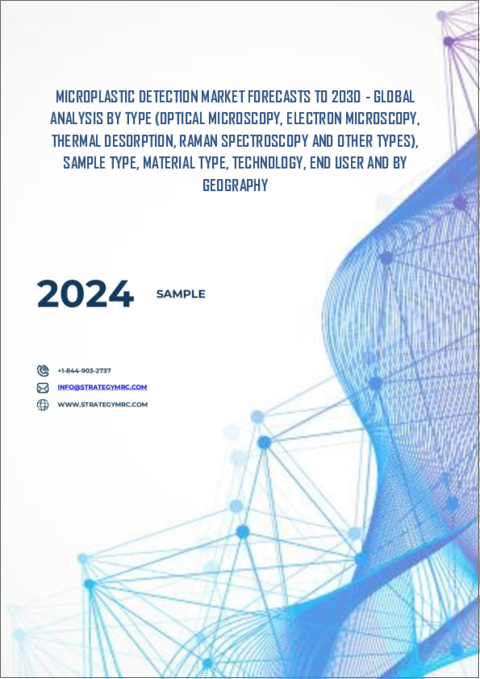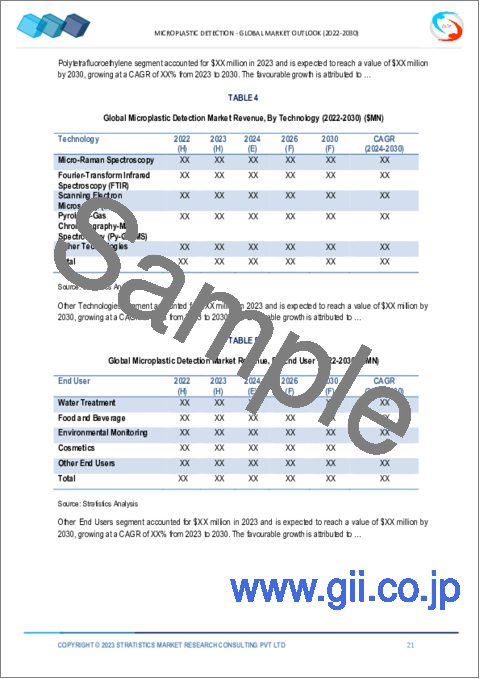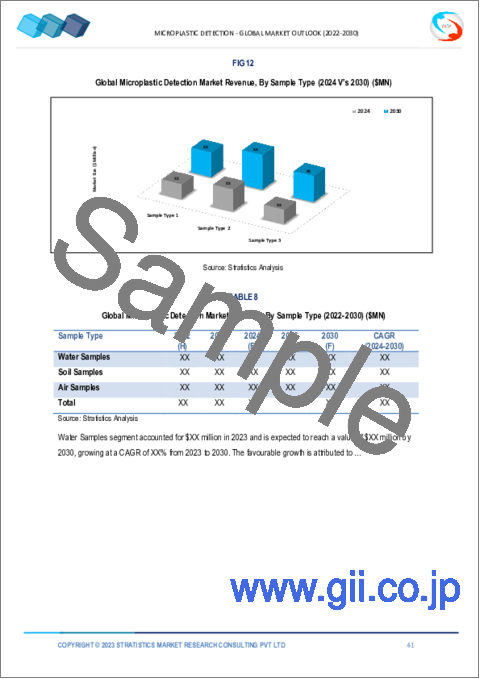|
|
市場調査レポート
商品コード
1587621
マイクロプラスチック検出市場の2030年までの予測: タイプ別、サンプルタイプ別、材料タイプ別、技術別、エンドユーザー別、地域別の世界分析Microplastic Detection Market Forecasts to 2030 - Global Analysis By Type (Optical Microscopy, Electron Microscopy, Thermal Desorption, Raman Spectroscopy and Other Types), Sample Type, Material Type, Technology, End User and By Geography |
||||||
カスタマイズ可能
|
|||||||
| マイクロプラスチック検出市場の2030年までの予測: タイプ別、サンプルタイプ別、材料タイプ別、技術別、エンドユーザー別、地域別の世界分析 |
|
出版日: 2024年11月11日
発行: Stratistics Market Research Consulting
ページ情報: 英文 200+ Pages
納期: 2~3営業日
|
全表示
- 概要
- 図表
- 目次
Stratistics MRCによると、世界のマイクロプラスチック検出市場は、2024年に47億米ドルを占め、予測期間中にCAGR 8.4%で成長し、2030年までに77億米ドルに達すると予想されています。
マイクロプラスチック検出は、水、土壌、空気などの環境サンプル中に存在する、一般的に5ミリメートル以下の小さなプラスチック粒子を特定し、測定することを含みます。このプロセスは、マイクロプラスチックのサイズ、形状、組成を確認するために、顕微鏡、分光法、化学分析を含む様々な技術を採用しています。
プラスチック・エナジーの調査によると、近赤外分光法を用いた欧州の選別施設では、マイクロプラスチックやその他のリサイクル困難な種類のプラスチックの回収率が約30%から90%以上に向上しています。
廃棄物管理における検出要件の増加
環境意識の高まりと規制強化により、廃棄物管理における検出要件が増加しています。マイクロプラスチックの生態系への影響に対する懸念が高まるにつれ、産業界は、廃棄物の流れに含まれるこれらの汚染物質を効果的に特定し定量化するために、高度な検出技術を採用せざるを得なくなっています。このシフトは、新しいガイドラインの遵守を確実にするだけでなく、持続可能な実践を促進し、廃棄物管理の取り組み全体の効果を高め、生態系を保護します。
複雑なサンプルマトリックス
複雑なサンプルマトリックスは、正確な同定と定量の妨げとなり、市場に大きな課題をもたらします。環境サンプルには、検出方法に干渉する可能性のある多様な有機物や無機物が含まれていることが多いです。これらの干渉は偽陽性や偽陰性を引き起こし、データの解釈を複雑にします。その結果、信頼性の高いマイクロプラスチックのモニタリングと環境評価には、これらの複雑な問題を扱うことのできる、堅牢で標準化された手法の必要性が不可欠です。
環境問題の高まり
マイクロプラスチックの生態系への影響に対する認識が高まるにつれて、環境に対する懸念が高まっていることが市場拡大の原動力となっています。海洋生物と人間の健康への有害な影響を強調し、社会と規制の監視が強まっています。その結果、産業界はマイクロプラスチック汚染を特定し、軽減するための高度な検出技術の導入を余儀なくされています。この転換は、持続可能性の目標をサポートするだけでなく、環境の完全性と公衆の福利を維持することを目的とした責任ある実践を促進します。
標準化の欠如
標準化の欠如は、研究や産業間で一貫した成果を測定し比較することを困難にし、市場に深刻な問題をもたらします。調査手法、検出限界、報告書式にばらつきがあると、データの解釈に食い違いが生じ、規制の妨げになります。このような矛盾は、環境への影響を正確に評価し、効果的な政策を策定する努力を複雑にし、最終的には生態系と人間の健康に蔓延するマイクロプラスチック汚染問題への取り組みの進展を遅らせることになります。
COVID-19の影響:
COVID-19の大流行は市場に大きな影響を与え、研究室や現場へのアクセスが制限されたために研究開発に混乱が生じた。緊急の保健上の優先事項への資金再配分により、進行中の研究が遅れ、新しい検出技術のイントロダクションが妨げられました。さらに、パンデミックの間に環境問題に対する人々の意識が高まったことで、マイクロプラスチック研究に対する関心が高まり、世界の危機がもたらした課題にもかかわらず、革新的な解決策に対する需要が生まれました。
電子顕微鏡セグメントは予測期間中最大になると予測される
電子顕微鏡分野は、予測期間中に最大の市場シェアを占めると予測されています。走査型電子顕微鏡(SEM)や透過型電子顕微鏡(TEM)などの技術により、研究者はマイクロプラスチックの形態、サイズ、組成をナノスケールで特定することができます。この詳細な特徴付けは、マイクロプラスチックの発生源とその環境影響の理解を深め、プラスチック汚染と闘う上で、より正確な評価と効果的な改善戦略を促進します。
予測期間中、飲食品分野のCAGRが最も高くなると予想されます。
食品・飲料分野は、予測期間中に最も高いCAGRを示すと予想されます。ボトル入り飲料水、水産物、包装食品を含む様々な製品にマイクロプラスチックが含まれていることが研究で確認されており、消費者の潜在的な健康リスクを高めています。規制機関や業界の利害関係者が食品の安全性を優先させる中、マイクロプラスチックの存在を評価・軽減し、製品の完全性と食品の安全性に対する消費者の信頼を確保するための信頼性の高い検出方法に対する需要が高まっています。
最大のシェアを占める地域:
北米地域が予測期間中最大の市場シェアを占めると予測されます。研究者や産業界は、水源、土壌、食品におけるマイクロプラスチック汚染に対処するための効果的な検出方法を積極的に模索しています。政府機関、学術機関、民間組織間の協力的な取り組みが、検出技術の革新を促進しています。このような持続可能性への関心の高まりは、地域全体で厳格なモニタリングと管理戦略を後押ししています。
CAGRが最も高い地域:
予測期間中、アジア太平洋地域が最も高い成長率を記録する見込みです。日本、中国、インドなどの国々は、水域や食物源に広く存在するマイクロプラスチックに対処するための調査を優先しています。高度な検出技術への投資の増加と規制枠組みの厳格化が技術革新を促進しています。さらに、一般市民の意識の高まりと積極的な活動は、利害関係者がこの地域全体で効果的なモニタリングと緩和戦略を実施することをさらに後押ししています。
無料カスタマイズサービス:
本レポートをご購読のお客様には、以下の無料カスタマイズオプションのいずれかをご利用いただけます:
- 企業プロファイル
- 追加市場プレイヤーの包括的プロファイリング(3社まで)
- 主要企業のSWOT分析(3社まで)
- 地域セグメンテーション
- 顧客の関心に応じた主要国の市場推計・予測・CAGR(注:フィージビリティチェックによる)
- 競合ベンチマーキング
- 製品ポートフォリオ、地理的プレゼンス、戦略的提携に基づく主要企業のベンチマーキング
目次
第1章 エグゼクティブサマリー
第2章 序文
- 概要
- ステークホルダー
- 調査範囲
- 調査手法
- データマイニング
- データ分析
- データ検証
- 調査アプローチ
- 調査情報源
- 1次調査情報源
- 2次調査情報源
- 前提条件
第3章 市場動向分析
- 促進要因
- 抑制要因
- 機会
- 脅威
- 技術分析
- エンドユーザー分析
- 新興市場
- COVID-19の影響
第4章 ポーターのファイブフォース分析
- 供給企業の交渉力
- 買い手の交渉力
- 代替品の脅威
- 新規参入業者の脅威
- 競争企業間の敵対関係
第5章 世界のマイクロプラスチック検出市場:タイプ別
- 光学顕微鏡
- 電子顕微鏡
- 熱脱着
- ラマン分光法
- その他のタイプ
第6章 世界のマイクロプラスチック検出市場:サンプルタイプ別
- 水サンプル
- 土壌サンプル
- 空気サンプル
第7章 世界のマイクロプラスチック検出市場:材料タイプ別
- ポリエチレン
- ポリテトラフルオロエチレン
- ポリプロピレン
- ポリスチレン
第8章 世界のマイクロプラスチック検出市場:技術別
- 顕微ラマン分光法
- フーリエ変換赤外分光法(FTIR)
- 走査型電子顕微鏡(SEM)
- 熱分解ガスクロマトグラフィー質量分析法(Py-GC-MS)
- その他の技術
第9章 世界のマイクロプラスチック検出市場:エンドユーザー別
- 水処理
- 食品・飲料
- 環境モニタリング
- 化粧品
- その他のエンドユーザー
第10章 世界のマイクロプラスチック検出市場:地域別
- 北米
- 米国
- カナダ
- メキシコ
- 欧州
- ドイツ
- 英国
- イタリア
- フランス
- スペイン
- その他欧州
- アジア太平洋
- 日本
- 中国
- インド
- オーストラリア
- ニュージーランド
- 韓国
- その他アジア太平洋地域
- 南米
- アルゼンチン
- ブラジル
- チリ
- その他南米
- 中東・アフリカ
- サウジアラビア
- アラブ首長国連邦
- カタール
- 南アフリカ
- その他中東とアフリカ
第11章 主な発展
- 契約、パートナーシップ、コラボレーション、合弁事業
- 買収と合併
- 新製品発売
- 事業拡大
- その他の主要戦略
第12章 企業プロファイリング
- Thermo Fisher Scientific
- Bruker Corporation
- Agilent Technologies
- Shimadzu Corporation
- PerkinElmer
- JASCO Corporation
- ZEISS Group
- Horiba, Ltd.
- Koehler Instrument Company, Inc.
- Ecovative Design LLC
- Aqualab Technologies, Inc.
- EnviroChemie GmbH
- Danaher Corporation
- Endress+Hauser Group Services AG
- Hach Company
List of Tables
- Table 1 Global Microplastic Detection Market Outlook, By Region (2022-2030) ($MN)
- Table 2 Global Microplastic Detection Market Outlook, By Type (2022-2030) ($MN)
- Table 3 Global Microplastic Detection Market Outlook, By Optical Microscopy (2022-2030) ($MN)
- Table 4 Global Microplastic Detection Market Outlook, By Electron Microscopy (2022-2030) ($MN)
- Table 5 Global Microplastic Detection Market Outlook, By Thermal Desorption (2022-2030) ($MN)
- Table 6 Global Microplastic Detection Market Outlook, By Raman Spectroscopy (2022-2030) ($MN)
- Table 7 Global Microplastic Detection Market Outlook, By Other Types (2022-2030) ($MN)
- Table 8 Global Microplastic Detection Market Outlook, By Sample Type (2022-2030) ($MN)
- Table 9 Global Microplastic Detection Market Outlook, By Water Samples (2022-2030) ($MN)
- Table 10 Global Microplastic Detection Market Outlook, By Soil Samples (2022-2030) ($MN)
- Table 11 Global Microplastic Detection Market Outlook, By Air Samples (2022-2030) ($MN)
- Table 12 Global Microplastic Detection Market Outlook, By Material Type (2022-2030) ($MN)
- Table 13 Global Microplastic Detection Market Outlook, By Polyethylene (2022-2030) ($MN)
- Table 14 Global Microplastic Detection Market Outlook, By Polytetrafluoroethylene (2022-2030) ($MN)
- Table 15 Global Microplastic Detection Market Outlook, By Polypropylene (2022-2030) ($MN)
- Table 16 Global Microplastic Detection Market Outlook, By Polystyrene (2022-2030) ($MN)
- Table 17 Global Microplastic Detection Market Outlook, By Technology (2022-2030) ($MN)
- Table 18 Global Microplastic Detection Market Outlook, By Micro-Raman Spectroscopy (2022-2030) ($MN)
- Table 19 Global Microplastic Detection Market Outlook, By Fourier-Transform Infrared Spectroscopy (FTIR) (2022-2030) ($MN)
- Table 20 Global Microplastic Detection Market Outlook, By Scanning Electron Microscopy (SEM) (2022-2030) ($MN)
- Table 21 Global Microplastic Detection Market Outlook, By Pyrolysis-Gas Chromatography-Mass Spectrometry (Py-GC-MS) (2022-2030) ($MN)
- Table 22 Global Microplastic Detection Market Outlook, By Other Technologies (2022-2030) ($MN)
- Table 23 Global Microplastic Detection Market Outlook, By End User (2022-2030) ($MN)
- Table 24 Global Microplastic Detection Market Outlook, By Water Treatment (2022-2030) ($MN)
- Table 25 Global Microplastic Detection Market Outlook, By Food and Beverage (2022-2030) ($MN)
- Table 26 Global Microplastic Detection Market Outlook, By Environmental Monitoring (2022-2030) ($MN)
- Table 27 Global Microplastic Detection Market Outlook, By Cosmetics (2022-2030) ($MN)
- Table 28 Global Microplastic Detection Market Outlook, By Other End Users (2022-2030) ($MN)
Note: Tables for North America, Europe, APAC, South America, and Middle East & Africa Regions are also represented in the same manner as above.
According to Stratistics MRC, the Global Microplastic Detection Market is accounted for $4.7 billion in 2024 and is expected to reach $7.7 billion by 2030 growing at a CAGR of 8.4% during the forecast period. Microplastic detection involves identifying and measuring tiny plastic particles, generally less than 5 millimeters in size, present in environmental samples such as water, soil, and air. This process employs various techniques, including microscopy, spectroscopy, and chemical analysis, to ascertain the size, shape, and composition of microplastics.
According to a study by the Plastic Energy, sorting facilities in Europe that use near- and infrared spectroscopy have raised collection rates of micro plastics and other hard-to-recycle plastic kinds from about 30% to over 90%.
Market Dynamics:
Driver:
Increased detection requirements in waste management
The market is seeing increased detection requirements in waste management, driven by rising environmental awareness and stricter regulations. As concerns about the ecological impact of microplastics grow, industries are compelled to adopt advanced detection technologies to effectively identify and quantify these contaminants in waste streams. This shift not only ensures compliance with new guidelines but also promotes sustainable practices, enhancing the overall effectiveness of waste management efforts and protecting ecosystems.
Restraint:
Complex sample matrices
Complex sample matrices pose substantial challenges in the market, hindering accurate identification and quantification. Environmental samples often contain diverse organic and inorganic materials that can interfere with detection methods. These interferences can lead to false positives or negatives, complicating data interpretation. As a result, the need for robust, standardized methodologies capable of handling these complexities is essential for reliable microplastic monitoring and environmental assessments.
Opportunity:
Growing environmental concerns
Growing environmental concerns are driving the expansion of the market as awareness of the ecological impact of microplastics rises. Public and regulatory scrutiny is increasing, highlighting the detrimental effects on marine life and human health. As a result, industries are compelled to implement advanced detection technologies to identify and mitigate microplastic contamination. This shift not only supports sustainability goals but also fosters responsible practices aimed at preserving environmental integrity and public well-being.
Threat:
Lack of standardization
Lack of standardization makes it difficult to measure and compare outcomes consistently across research and industries, which presents serious issues for the market. Variations in methodologies, detection limits, and reporting formats lead to discrepancies in data interpretation and hinder regulatory efforts. This inconsistency complicates efforts to assess environmental impacts accurately and develop effective policies, ultimately slowing progress in addressing the pervasive issue of microplastic pollution in ecosystems and human health.
Covid-19 Impact:
The COVID-19 pandemic significantly impacted the market, causing disruptions in research and development due to restricted access to laboratories and field sites. Funding reallocations to urgent health priorities delayed ongoing studies and hindered the introduction of new detection technologies. Additionally, heightened public awareness of environmental issues during the pandemic led to increased interest in microplastic research, creating a demand for innovative solutions, despite the challenges posed by the global crisis.
The electron microscopy segment is projected to be the largest during the forecast period
The electron microscopy segment is projected to account for the largest market share during the projection period. Techniques such as scanning electron microscopy (SEM) and transmission electron microscopy (TEM) allow researchers to identify the morphology, size, and composition of microplastics at the nanoscale. This detailed characterization enhances the understanding of microplastic sources and their environmental impact, facilitating more accurate assessments and effective remediation strategies in combating plastic pollution.
The food and beverage segment is expected to have the highest CAGR during the forecast period
The food and beverage segment is expected to have the highest CAGR during the extrapolated period. Studies have identified microplastics in various products, including bottled water, seafood, and packaged foods, raising potential health risks for consumers. As regulatory bodies and industry stakeholders prioritize food safety, there is a growing demand for reliable detection methods to assess and mitigate microplastic presence, ensuring product integrity and consumer confidence in food safety.
Region with largest share:
North America region is projected to account for the largest market share during the forecast period. Researchers and industries are actively seeking effective detection methods to address microplastic contamination in water sources, soil, and food products. Collaborative efforts between government agencies, academic institutions, and private organizations are fostering innovation in detection technologies. This heightened focus on sustainability is pushing for stringent monitoring and management strategies across the region.
Region with highest CAGR:
Asia Pacific is expected to register the highest growth rate over the forecast period. Countries like Japan, China, and India are prioritizing research to address the widespread presence of microplastics in water bodies and food sources. Increasing investments in advanced detection technologies and stricter regulatory frameworks are driving innovation. Additionally, heightened public awareness and activism are further pushing stakeholders to implement effective monitoring and mitigation strategies across the region.
Key players in the market
Some of the key players in Microplastic Detection market include Thermo Fisher Scientific, Bruker Corporation, Agilent Technologies, Shimadzu Corporation, PerkinElmer, JASCO Corporation, ZEISS Group, Horiba, Ltd., Koehler Instrument Company, Inc., Ecovative Design LLC, Aqualab Technologies, Inc., EnviroChemie GmbH, Danaher Corporation, Endress+Hauser Group Services AG and Hach Company.
Key Developments:
In January 2023, Shimadzu Corporation announced the release of the AIMsight infrared microscope in Japan and overseas. This instrument easily and automatically measures micro targets by irradiating them with infrared rays, and then investigating the reflectance and transmittance..
In October 2022, Agilent Technologies has released its enhanced 8700 LDIR Chemical Imaging System, which has been further optimized for the analysis of microplastics in environmental samples.
Types Covered:
- Optical Microscopy
- Electron Microscopy
- Thermal Desorption
- Raman Spectroscopy
- Other Types
Sample Types Covered:
- Water Samples
- Soil Samples
- Air Samples
Material Types Covered:
- Polyethylene
- Polytetrafluoroethylene
- Polypropylene
- Polystyrene
Technologies Covered:
- Micro-Raman Spectroscopy
- Fourier-Transform Infrared Spectroscopy (FTIR)
- Scanning Electron Microscopy (SEM)
- Pyrolysis-Gas Chromatography-Mass Spectrometry (Py-GC-MS)
- Other Technologies
End Users Covered:
- Water Treatment
- Food and Beverage
- Environmental Monitoring
- Cosmetics
- Other End Users
Regions Covered:
- North America
- US
- Canada
- Mexico
- Europe
- Germany
- UK
- Italy
- France
- Spain
- Rest of Europe
- Asia Pacific
- Japan
- China
- India
- Australia
- New Zealand
- South Korea
- Rest of Asia Pacific
- South America
- Argentina
- Brazil
- Chile
- Rest of South America
- Middle East & Africa
- Saudi Arabia
- UAE
- Qatar
- South Africa
- Rest of Middle East & Africa
What our report offers:
- Market share assessments for the regional and country-level segments
- Strategic recommendations for the new entrants
- Covers Market data for the years 2022, 2023, 2024, 2026, and 2030
- Market Trends (Drivers, Constraints, Opportunities, Threats, Challenges, Investment Opportunities, and recommendations)
- Strategic recommendations in key business segments based on the market estimations
- Competitive landscaping mapping the key common trends
- Company profiling with detailed strategies, financials, and recent developments
- Supply chain trends mapping the latest technological advancements
Free Customization Offerings:
All the customers of this report will be entitled to receive one of the following free customization options:
- Company Profiling
- Comprehensive profiling of additional market players (up to 3)
- SWOT Analysis of key players (up to 3)
- Regional Segmentation
- Market estimations, Forecasts and CAGR of any prominent country as per the client's interest (Note: Depends on feasibility check)
- Competitive Benchmarking
- Benchmarking of key players based on product portfolio, geographical presence, and strategic alliances
Table of Contents
1 Executive Summary
2 Preface
- 2.1 Abstract
- 2.2 Stake Holders
- 2.3 Research Scope
- 2.4 Research Methodology
- 2.4.1 Data Mining
- 2.4.2 Data Analysis
- 2.4.3 Data Validation
- 2.4.4 Research Approach
- 2.5 Research Sources
- 2.5.1 Primary Research Sources
- 2.5.2 Secondary Research Sources
- 2.5.3 Assumptions
3 Market Trend Analysis
- 3.1 Introduction
- 3.2 Drivers
- 3.3 Restraints
- 3.4 Opportunities
- 3.5 Threats
- 3.6 Technology Analysis
- 3.7 End User Analysis
- 3.8 Emerging Markets
- 3.9 Impact of Covid-19
4 Porters Five Force Analysis
- 4.1 Bargaining power of suppliers
- 4.2 Bargaining power of buyers
- 4.3 Threat of substitutes
- 4.4 Threat of new entrants
- 4.5 Competitive rivalry
5 Global Microplastic Detection Market, By Type
- 5.1 Introduction
- 5.2 Optical Microscopy
- 5.3 Electron Microscopy
- 5.4 Thermal Desorption
- 5.5 Raman Spectroscopy
- 5.6 Other Types
6 Global Microplastic Detection Market, By Sample Type
- 6.1 Introduction
- 6.2 Water Samples
- 6.3 Soil Samples
- 6.4 Air Samples
7 Global Microplastic Detection Market, By Material Type
- 7.1 Introduction
- 7.2 Polyethylene
- 7.3 Polytetrafluoroethylene
- 7.4 Polypropylene
- 7.5 Polystyrene
8 Global Microplastic Detection Market, By Technology
- 8.1 Introduction
- 8.2 Micro-Raman Spectroscopy
- 8.3 Fourier-Transform Infrared Spectroscopy (FTIR)
- 8.4 Scanning Electron Microscopy (SEM)
- 8.5 Pyrolysis-Gas Chromatography-Mass Spectrometry (Py-GC-MS)
- 8.6 Other Technologies
9 Global Microplastic Detection Market, By End User
- 9.1 Introduction
- 9.2 Water Treatment
- 9.3 Food and Beverage
- 9.4 Environmental Monitoring
- 9.5 Cosmetics
- 9.6 Other End Users
10 Global Microplastic Detection Market, By Geography
- 10.1 Introduction
- 10.2 North America
- 10.2.1 US
- 10.2.2 Canada
- 10.2.3 Mexico
- 10.3 Europe
- 10.3.1 Germany
- 10.3.2 UK
- 10.3.3 Italy
- 10.3.4 France
- 10.3.5 Spain
- 10.3.6 Rest of Europe
- 10.4 Asia Pacific
- 10.4.1 Japan
- 10.4.2 China
- 10.4.3 India
- 10.4.4 Australia
- 10.4.5 New Zealand
- 10.4.6 South Korea
- 10.4.7 Rest of Asia Pacific
- 10.5 South America
- 10.5.1 Argentina
- 10.5.2 Brazil
- 10.5.3 Chile
- 10.5.4 Rest of South America
- 10.6 Middle East & Africa
- 10.6.1 Saudi Arabia
- 10.6.2 UAE
- 10.6.3 Qatar
- 10.6.4 South Africa
- 10.6.5 Rest of Middle East & Africa
11 Key Developments
- 11.1 Agreements, Partnerships, Collaborations and Joint Ventures
- 11.2 Acquisitions & Mergers
- 11.3 New Product Launch
- 11.4 Expansions
- 11.5 Other Key Strategies
12 Company Profiling
- 12.1 Thermo Fisher Scientific
- 12.2 Bruker Corporation
- 12.3 Agilent Technologies
- 12.4 Shimadzu Corporation
- 12.5 PerkinElmer
- 12.6 JASCO Corporation
- 12.7 ZEISS Group
- 12.8 Horiba, Ltd.
- 12.9 Koehler Instrument Company, Inc.
- 12.10 Ecovative Design LLC
- 12.11 Aqualab Technologies, Inc.
- 12.12 EnviroChemie GmbH
- 12.13 Danaher Corporation
- 12.14 Endress+Hauser Group Services AG
- 12.15 Hach Company






